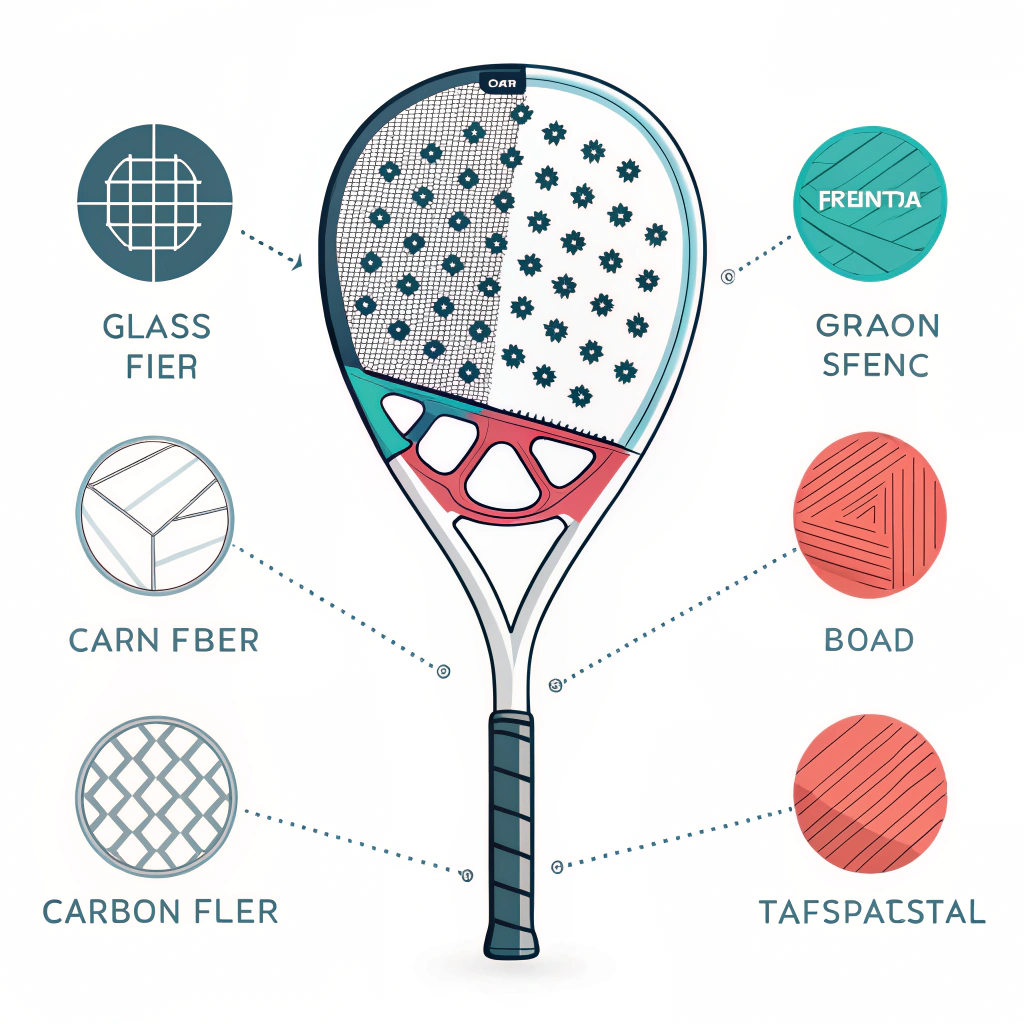A padel racket is more than just a sports tool—it is a carefully engineered blend of materials and design choices that can significantly influence a player's performance, especially for beginners. In this guide, we explain the most important components and materials—ranging from glass fiber1 to various types of carbon fiber2—and how different designs suit varying skill levels, performance needs, and business objectives.
Understanding the construction and component materials of a padel racket is key to delivering a product that balances power, control, and durability. As a B2B professional new to the padel market, knowing the details about materials, shapes (Diamond, Round, Teardrop), and customization3 options will enable you to make informed decisions when designing or sourcing rackets for your customers.
The padel equipment market is evolving rapidly, and many sports equipment professionals face a steep learning curve when transitioning from traditional sporting goods to padel rackets. Key challenges include:
• Distinguishing between different materials (e.g., glass fiber versus carbon fiber types such as 3k, 12k, and 18k)
• Matching racket weight with player skill level and game style
• Understanding how racket shape (Diamond, Round, Teardrop) influences play
• Deciding on left-over customization aspects like handgrip design and finish
For professionals considering retail or product lines in the padel industry, these factors directly impact product positioning and inventory decisions.
Padel rackets use specialized materials that determine their performance attributes. Manufacturers like NEX Padel employ advanced production techniques4 and leverage materials such as:
• Glass Fiber: Provides a flexible and forgiving structure, ideal for absorbing impact, especially beneficial in beginner rackets.
• Carbon Fiber (3k, 12k, 18k): Offers varying levels of stiffness, responsiveness, and overall durability.
- 3k Carbon: Known for its flexibility and ease of control, suitable for beginners.
- 12k and 18k Carbon: Provide higher performance in terms of power and precision, appealing to more experienced players and competitive markets.
Understanding these materials is crucial since they dictate not only the on-court performance but also the quality and longevity of the product—a critical factor when catering to a global market with diverse playing styles.
Below is a detailed look at the main design elements that influence a padel racket's performance:
Weight directly affects manoeuvrability and control. For beginners, a lightweight racket (generally around 350-360g) is recommended. Lighter rackets reduce strain on the wrist and arm, permitting quicker reactions and smoother handling. Balanced rackets, where the weight is evenly distributed, help beginners achieve an optimal mix of power and control.
Racket shape is one of the most important factors in design:
• Diamond Shape: Typically built for players seeking extra power. The head-heavy balance can generate high-impact shots but might require more skill to control.
• Round Shape: Emphasizes control and forgiveness, making it ideal for beginners who need a stable racket for consistent ball contact.
• Teardrop Shape: Offers a compromise between power and control, appealing to players aiming to progress from beginner to intermediate levels.
Each shape brings a unique balance of characteristics that impact shot accuracy, power, and overall playstyle.
The choice and quality of materials not only influence performance but also durability. At NEX Padel, we offer high-performance options ranging from glass fiber to multiple grades of carbon fiber. Furthermore, customization extends beyond the core structure:
• Custom Shapes: Beyond standard shapes, full customizations allow tailoring the design for niche market requirements.
• Printed Designs and Colors: Enhance brand identity while allowing players to choose aesthetically pleasing solutions.
• Hand Grip and Handle Covers: These can also be customized with logos and specific design attributes, ensuring comfort and visual appeal.
Another important aspect is the manufacturing process. Rapid prototyping5 and high precision in production ensure that even custom-designed rackets meet industry standards. NEX Padel’s collaboration with established brands and adherence to strict quality control means that every product is built to satisfy both performance metrics and the unique needs of varied markets.
Below is a comparison table that distills key attributes of each core material used in padel rackets:
| Material Type | Flexibility | Durability | Performance Contribution | Ideal For |
|---|---|---|---|---|
| Glass Fiber | High | Moderate | Enhances shock absorption and control | Beginners and casual players |
| 3k Carbon Fiber | Moderate | High | Balances control and power | Entry-level competitive play |
| 12k Carbon Fiber | Low-Moderate | Very High | Increases rigidity and precision | Intermediate players |
| 18k Carbon Fiber | Low | Highest | Maximizes power and precision | Advanced competitive players |
Each material has its strengths. For B2B customers, understanding these differences facilitates better decision-making in stocking or designing rackets that meet targeted player segments.
Consider the experience of some industry leaders like Hirostar and Reebok, who have partnered with manufacturers like NEX Padel. These collaborations demonstrate how leveraging high-performance materials and customizable designs can meet diverse market demands:
• Challenge: Balancing the need for a racket that is both power-oriented and control-friendly.
• Solution: Customizing the racket shape (choosing between Round and Teardrop) combined with a lightweight design (350-360g).
• Outcome: The resultant product not only met performance benchmarks but also solved ergonomic challenges for novice players, thereby opening new avenues in the retail market.
This case clearly illustrates how advanced material choices, together with flexible design options, allow companies to tailor products effectively for different market segments.
When curating a product line or seeking a manufacturing partner, consider these actionable insights:
-
Identify Your Target Play Level:
- For beginners, look for rackets that emphasize control and ease of use.
- For intermediate and advanced players, consider a balanced design that incorporates both power and precision.
-
Check Material Specifications:
- Ensure that the rackets use the appropriate type of carbon fiber or glass fiber for the intended performance metrics.
- Request product samples and quality certifications.
-
Customization Capabilities:
- Evaluate if the manufacturer offers full customization, from racket shape to enhanced gripping options.
- Branding elements like logos on the hand grip and handle covers can add perceived value for end consumers.
-
Production Efficiency:
- Timely delivery and consistent quality control are key advantages in today's fast-paced market.
- Factor in rapid prototyping capabilities if you require tailored solutions quickly.
-
Market Trend Analysis:
- Keep an eye on evolving trends in padel sports. For example, increasing emphasis on ergonomics and aesthetics can be a deciding factor for retailers.
Here is a summary table for quick reference:
| Guideline | Key Consideration | Action Step |
|---|---|---|
| Target Play Level | Beginner vs. Intermediate vs. Advanced | Choose design and material based on player level |
| Material Specifications | Glass Fiber vs. Different Grades of Carbon Fiber | Request detailed specs and product samples |
| Customization Capabilities | Racket Shape, Hand Grip, Branding | Evaluate manufacturer's customization services |
| Production Efficiency | Turnaround Times, Quality Control | Assess manufacturer’s production processes |
| Market Trend Analysis | Ergonomics, Power, Visual Appeal | Monitor market trends and adjust product offerings |
Adopting a systematic approach to product selection and customization will empower your business to offer high-performance padel rackets that cater effectively to diverse customer needs.
In a competitive market, understanding the nuances of padel racket components is essential for successful product management. By considering factors such as material quality, design shape, weight, and customization capabilities, you can align product offerings with the evolving needs of both new and seasoned players.
For B2B professionals in sports equipment, a deeper understanding of these production details will support more strategic sourcing decisions and enhance competitive advantage. Whether you need rackets for beginners prioritizing ease of use or for advanced players demanding precision and power, a careful evaluation of these components will pave the way for success in your product portfolio.
We encourage you to continuously monitor production innovations and market trends. This proactive approach not only helps in optimizing the product line but also in maintaining a leadership position in the padel equipment industry. Reach out to experts or schedule a consultation to explore custom manufacturing that meets your unique business requirements.
• How to choose a padel racket for beginners?
For beginners, choose a lightweight racket (350-360g) that prioritizes manoeuvrability and minimizes strain. Look for designs that emphasize control, such as round-shaped rackets, which tend to offer forgiving performance and ease of handling.
• What is the difference between beginner and intermediate padel rackets?
Beginner rackets typically focus on forgiveness and control, offering a stable playing experience with less power. On the other hand, intermediate rackets are designed to provide a balanced mix of power and control, enabling gradual performance improvement as the player's skill level advances.
• What to look for in a good padel racket?
A good padel racket should offer the right balance between weight, balance, and materials. Key factors include the racket’s shape, overall weight distribution, handle size for comfortable grip, and the quality of materials used to ensure durability and a precise performance impact.
-
Glass Fiber: Click to learn about the properties of glass fiber, including its role in enhancing racket flexibility and impact absorption, which is essential for products aimed at beginners. ↩ ↩
-
Carbon Fiber: Click to read further on carbon fiber technologies, the differences between its various grades, and how they affect performance in both control and power-oriented rackets. ↩ ↩
-
Customization: Click to delve into customization options in sports equipment manufacturing, explaining how tailored design features can meet specific market needs and enhance brand identity. ↩ ↩
-
Advanced Production Techniques: Click to explore advanced production techniques used in modern racket manufacturing, detailing how precision and innovative processes lead to improved product quality. ↩ ↩
-
Rapid Prototyping: Click to understand rapid prototyping in manufacturing, its benefits in reducing turnaround times, and enhancing customization in product design. ↩ ↩







